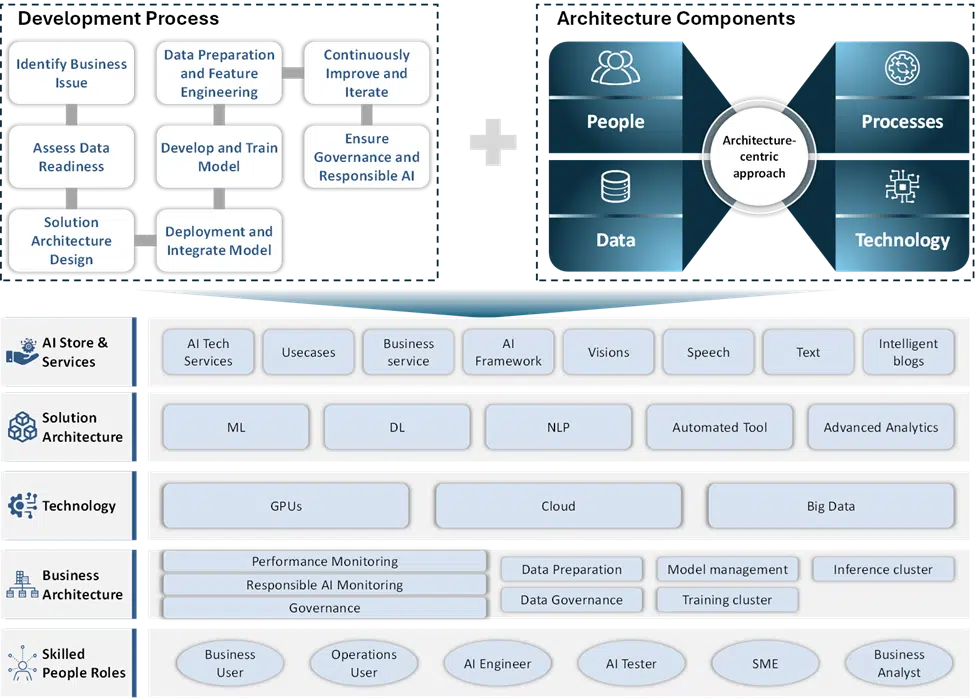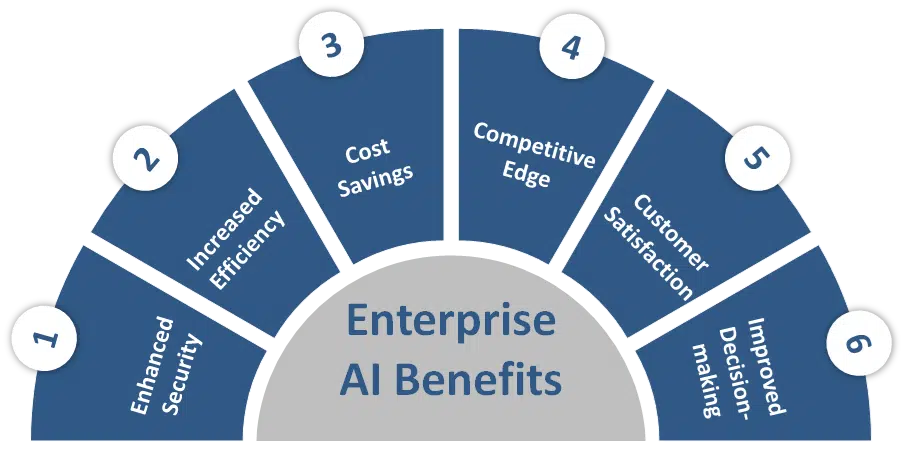In the rapidly evolving digital landscape, enterprises are striving to revolutionize the business operations to stay competitive in the market. The integration of latest technologies such as Artificial Intelligence (AI) and Generative AI (Gen AI) and its capabilities can streamline the business operations with better efficiency through automation and data-driven decision-making. There comes the significance of Enterprise AI! Enterprise AI is a subset of enterprise software facilitating businesses to achieve increased efficiency, productivity, and profitability.
Enterprise AI platforms aim at proper incorporation of AI features to an established organizational setup. This leads to diverse possibilities with AI-driven solutions. Enterprise AI platforms are meant to popularize AI thus making it available and accommodative by entities regardless of their size.
Through adoption of enterprise AI solutions, change is seen in problem solving, analysis of information and strategic planning. The AI systems have become more sophisticated over time thus allowing easier access even for smaller companies into this power-filled new field. However, before you can leverage the benefits of enterprise AI solutions and platforms, you need to understand its architectural components and how to build it. The blog details about what is Enterprise AI solution, the key architectural components of Enterprise AI and the key challenges involved in its development.
Enterprise AI solution is an AI-driven and enhanced technology designed and developed to resolve business challenges and constraints to realize enhanced operations. Enterprise AI solutions result in a point where management and deployment take place from one place by streamlining data ingestion, model training, and deploying the model which involves everything from data importation to training and eventual deployment of the said model. This helps in assisting organizations in automating decision-making processes. The capabilities of these platforms range from text data mining to predictive analytics, to Natural Language Processing (NLP) and computer vision, amongst other functionalities.
Enterprise AI solution consists of enterprise AI application which utilize AI technologies to achieve business efficiency. For instance, enterprise AI applications such as customer service chatbots to interact with customers in real-time, that understand and respond to customer inquiries in real-time, and fraud detection systems to categorize fraudulent activity.
To beat the technological evolution, enterprises should embrace latest trends and technologies to stay competitive. The integration of AI in business process and operations helps enterprise to realize seamless and exceptional services to end users. Hence, enterprise AI has gained more traction in companies to underpin larger productivity and enhanced operational efficiency. Now, let us delve into how to build Enterprise AI solution.
The development process for enterprise AI solutions can vary based on each organization’s unique needs. The specific architecture and the inclusion of key components may vary depending on the enterprise’s size, industry, data landscape, and AI maturity. A well-designed enterprise AI platform will provide a comprehensive, scalable, and secure foundation for organizations to leverage AI and machine learning capabilities to drive business success. The following image illustrates the key architectural components and the development workflow of Enterprise AI.

The architectural components of an enterprise AI platform typically include the following key elements:
The development workflow consists of the following elements:
Bringing together these diverse components and developing an enterprise AI solution that caters to specific business needs is no mean feat. The integration of key architectural components of Enterprise AI and development workflow lead to the Enterprise AI architecture as shown in the image below:

Throughout this development process, it is essential to adopt a collaborative and iterative approach, involving cross-functional teams (e.g., business, data science, IT, compliance) to ensure the enterprise AI solution aligns with the business’s strategic goals and delivers the desired business outcomes. The usage of efficient technologies such as Machine Learning (ML), Deep Learning (DL), and Natural Language Processing (NLP) can be enablers to realize a better solution or application framework to support Enterprise AI services.
However, developing an enterprise AI solution is not without its set of challenges.
When developing an enterprise AI platform, you will need to align the AI models to the business objectives. But this is no simple task and can result in challenges arising in different areas as listed in the table below.
| Challenges | Description |
| Data Challenges | – Integrating and managing diverse, messy data from various sources. – Ensuring data quality, consistency, and addressing missing data, biases, and privacy concerns. |
| Scalability and Performance Challenges | – Handling growing data volume and complex models. – Providing efficient training and real-time processing for critical applications. |
| Model Development and Deployment Challenges | – Choosing the right AI techniques for the business problem. – Automating development, testing, deployment, and managing model versions in production. |
| Governance and Compliance Challenges | – Establishing responsible AI development practices. – Ensuring compliance with regulations and data privacy laws. – Implementing methods to understand how models arrive at their decisions. |
| Collaboration and Workflow Integration Challenges | – Enabling collaboration between data scientists, IT, and business teams. – Blending the AI platform into existing workflows and systems. – Holistically, designing interfaces that are captivating, automatically navigable and less focused on technology among the users. |
| Talent and Skill Gaps Challenges | – Finding and keeping AI/ML professionals with the right expertise. – Bridging the knowledge gap between business and technical teams through initiating organizational changes aimed at enhancing care and concern for the impacted. – Upskilling the existing workforce to leverage the AI platform effectively as part of transformation strategies. |
| Change Management and Adoption Challenges | – Driving user adoption and overcoming resistance to AI. – Developing training and support programs for end-users. – Continuously monitoring and addressing user feedback. |
| Enterprise-Grade Security and Reliability Challenges | – Ensuring robust security, access controls, and data protection measures. – Implementing high availability, fault tolerance, and disaster recovery mechanisms. – Maintaining overall platform stability and reliability. |
Addressing these challenges requires a cross-functional collaboration, a strong governance framework, and a focus on continuous improvement and adaptation. But with the right strategic approach and a plan for dealing with these challenges, you can successfully develop an enterprise AI platform that aligns with your organization’s overall business objectives and IT infrastructure.
This might seem like a lengthy, time-consuming process, so you may be wondering if all the effort is going to be worth it. Well, let’s do a brief overview of the benefits of enterprise AI solutions.
When you incorporate corporate AI technology in your operations, you unleash some hidden capabilities. AI’s role in any organization is to facilitate streamlined operations, enable informed choices and promote effectiveness. Beyond this, such platforms may lead to delegation of routine functions hence releasing employees to handle more important tasks as well as giving intelligent advice that guides long-term business actions.

Decision-making in companies is greatly improved because of adding artificial intelligence which provides intelligence based on data thus challenging you to think out-of-the-box and improve strategic planning as well as problem solving tactics.
And let’s not forget the customer experience. AI-powered applications and services can elevate engagement, anticipate needs, and deliver personalized interactions that attract and retain clients. All while ensuring robust data protection and compliance throughout your AI implementation.
But all of this can only be achieved by developing a custom enterprise AI solution that considers your organization’s unique needs, limitations, and IT infrastructure. This requires multiple considerations and integrating various components, which can make it a complex process.
Building an enterprise AI solution can solve many business challenges by leveraging appropriate AI technologies. This in turn brings many benefits such as enhanced operations, better efficiency and business growth to remain competitive in the dynamic marketplace.
Calsoft, being a technology-first partner, with 25+ years of experience Calsoft helps customers solve their business challenges. Our expertise lies in Big Data Analytics, AI, and Gen AI focusing on enterprises and ISVs. Explore Calsoft AI solution that caters to your specific needs.